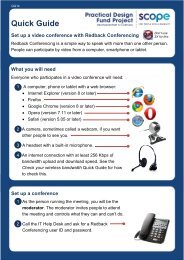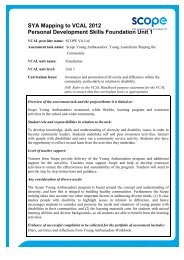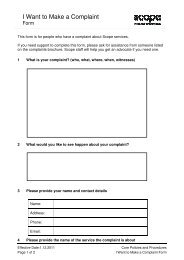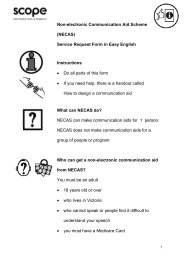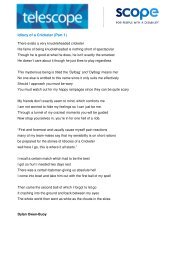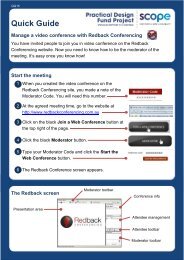Positive behaviour support Getting it right from the start
Positive behaviour support Getting it right from the start
Positive behaviour support Getting it right from the start
You also want an ePaper? Increase the reach of your titles
YUMPU automatically turns print PDFs into web optimized ePapers that Google loves.
58 <strong>Pos<strong>it</strong>ive</strong> <strong>behaviour</strong> <strong>support</strong>: <strong>Getting</strong> <strong>it</strong> <strong>right</strong> <strong>from</strong> <strong>the</strong> <strong>start</strong> - Facil<strong>it</strong>ators reference manual<br />
Behaviour recording<br />
PowerPoint Key steps in completing a functional <strong>behaviour</strong> assessment<br />
80*<br />
Step 1: Defining <strong>the</strong> <strong>behaviour</strong> of concern<br />
Need to wr<strong>it</strong>e <strong>the</strong> <strong>behaviour</strong> in a way that <strong>the</strong> actual <strong>behaviour</strong> of concern can be easily<br />
understood by o<strong>the</strong>rs and that <strong>the</strong>n can be used to gain reliable documentation on when<br />
and when <strong>it</strong> does not occur.<br />
Step 2: Finding out as much information as possible about <strong>the</strong> <strong>behaviour</strong>, which is<br />
information on:<br />
• What happens before <strong>the</strong> <strong>behaviour</strong>?<br />
• What happens during <strong>the</strong> <strong>behaviour</strong>?<br />
• What happens after <strong>the</strong> <strong>behaviour</strong>?<br />
This will require <strong>the</strong> use of recording forms such as STAR Charts or questionnaires like <strong>the</strong>,<br />
Motivational Assessment Scale. 19<br />
Step 3: From information collated via <strong>the</strong> recording forms/questionnaires, come up w<strong>it</strong>h an<br />
idea (hypo<strong>the</strong>sis) about why <strong>the</strong> <strong>behaviour</strong> is occurring, that is what purpose/function does<br />
<strong>the</strong> <strong>behaviour</strong> appear to be serving for <strong>the</strong> person. Some of <strong>the</strong> most common reasons why<br />
<strong>behaviour</strong>s of concern occur:<br />
• Gaining social interaction<br />
• Escape or avoidance of demands<br />
• Gaining access to referred activ<strong>it</strong>ies or tangible objects<br />
• Sensory feedback (hand flapping, eye poking)<br />
• Pursu<strong>it</strong> of power and control over own life<br />
• Reduction of arousal and anxiety.<br />
Step 4: Test your idea (hypo<strong>the</strong>sis) by systematically introducing strategies such as<br />
environmental changes, skill development strategies and planned responses to <strong>behaviour</strong>s.<br />
These strategies must be linked to why <strong>the</strong> person is using <strong>the</strong> <strong>behaviour</strong>. The introduction and<br />
consistent implementation of <strong>the</strong>se strategies should result in a reduction to <strong>the</strong> frequency and<br />
intens<strong>it</strong>y of <strong>the</strong> target <strong>behaviour</strong> and over time, an increase in <strong>the</strong> person’s qual<strong>it</strong>y of life.<br />
Step 5: Regularly mon<strong>it</strong>or, evaluate and review <strong>the</strong> effectiveness of <strong>the</strong> strategies: Thinking about<br />
what worked and what needs to change. Ongoing data collection will be required to mon<strong>it</strong>or or<br />
check that your ideas about <strong>the</strong> <strong>behaviour</strong> are correct.<br />
19. Motivation Assessment Scale Durand and Crimmins 1992




